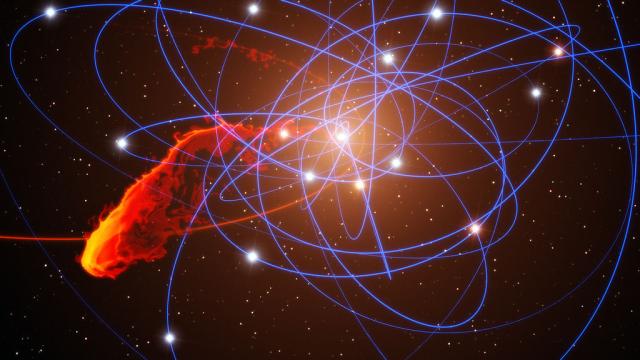An attempt to prove Einstein’s hallmark theory of gravity revealed something even freakier: an unprecedented flash from the black hole at the centre of our galaxy.
The Milky Way features a black hole that’s 4 million times the mass of the Sun, called Sagittarius A* (pronounced A-star). One team of scientists has been measuring it for over 20 years, and back in May, they observed a flash of infrared radiation that was brighter than had ever been measured from the black hole. It’s not something to worry about, but it will be an exciting development for astronomers to try and understand.
“We can see it changing in real time,” Tuan Do, the study’s first author and an associated research scientist at UCLA, told Gizmodo. “You usually don’t get to do that in astrophysics.”
The team of scientists observed the galactic centre for four nights this year using an infrared camera on the Keck II Telescope. On May 13, the amount of infrared light it emitted increased by 75 times in just two hours, according to the paper published in Astrophysical Journal Letters. It also flashed brightly on April 20, and dimmed quickly on the nights it flashed. Do explained that the statistical analysis that followed the observation demonstrated that the event was usual.
Black holes are objects so dense that beyond a zone called the event horizon, their gravitational field warps space to the point that light can’t escape. But they can still spew radiation from outside their event horizon, the result of interaction with gas and stars that come too close.
Here’s a timelapse of images over 2.5 hr from May from @keckobservatory of the supermassive black hole Sgr A*. The black hole is always variable, but this was the brightest we’ve seen in the infrared so far. It was probably even brighter before we started observing that night! pic.twitter.com/MwXioZ7twV
— Tuan Do (@quantumpenguin) August 11, 2019
Such a glancing interaction might have been behind this recent bright flash. This scientists were especially interested in a star orbiting close to the galactic center called SO-2. They hoped to test Einstein’s theory of how gravity works, called general relativity, and found that the black hole did indeed warp the star’s light as predicted by the theory. Perhaps, said Do, SO-2 modified the gas flow into the black hole and caused the temporary flash. Or maybe the flash came from the delayed reaction of another puffy object that recently passed by the center, called G2. More observations will hopefully help scientists figure it out for sure.
This isn’t the only group that’s monitoring SO-2 and Sag A*. Another team of astronomers operating the European Southern Observatory’s Very Large Telescope have also measured the light-stretching effects of the black hole (they call the star S2, but it’s the same star). Do is curious to see whether this team also measured the flash.
Ultimately, researchers are interested in whether the black hole is more active than usual, and if so, how long the increased activity will last, according to the paper.
